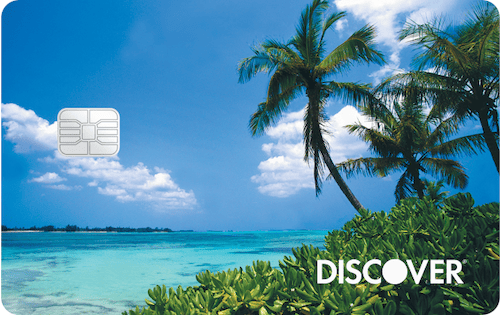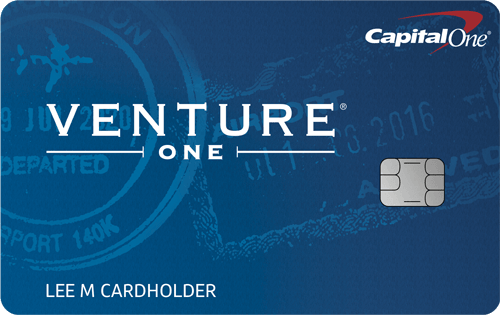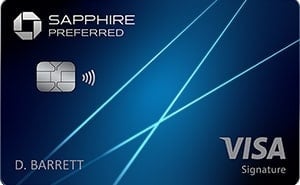Some links in this post include referral benefits. This means, I get a small points bonus when people sign up using my referral links. This doesn’t cost you a thing, but does support my website and my time spent putting posts together.
When I started using travel credit cards 7 years ago, I stuck to a few solid entry level cards.


Now?
I’m a fan of the travel card that sits near the top of everyone else’s ‘best’ credit cards list.
The Chase Sapphire Preferred card.

Super original, I know.
I also recently picked up the Southwest Rapid Rewards Plus card to take advantage of the companion pass promo for 2022.
Before we get into the 2 best travel credit cards for miles, in my opinion, I’d like to note 2 major things.
1) Travel credit cards only work financially if used as debit cards. Meaning, you MUST pay off your balances in full every month. Paying interest will never be worth the sign on bonus or travel benefits.
2) Travel credit cards with minimum spend bonuses should be used to buy things you would be buying anyway.
The point is, travel hacking is a game. The goal is to play the game and win, which you can do, pretty easily.
With a little organization, attention to detail, and research, adding a rewards credit card to your wallet is something that can benefit your life.
I’d argue everyone should have at least one solid rewards card in their credit portfolio, if you will.

Discover It Miles Card

The Discover It Miles card was the first travel card I signed up for.
Revisiting the perks, I can see why.
With no annual fee, a higher than average points per dollar value, and an unlimited sign on bonus where Discover matches all miles acquired in the first year, this card is an easy sell.
In essence, you get 3x miles per $1 spent in the first year on every single purchase.
Obviously this bonus benefits higher spenders the most, but as a young just-out-of college girl, I can vouch that I was able to use this card to help pay for quite a few flights, even with my rate of spending.
The perks:
- 1.5x points per $1
- Unlimited bonus – Discover matches all points earned in the first year (3x points!)
- $0 annual fee
- Redeem points for travel
- Redeem points for statement credits or for cash
- Miles never expire
What are Points Worth?
Discover It Miles points are worth 1 cent. Each dollar spent is equivalent to 1.5 cents in points.
This rewards value allows you to estimate what your bonus will be at the end of the year.
Pros
Easy to understand, easy to use.
This card is one of the most straightforward cards out there.
Sign up and spend like normal → Get 1.5 points on every dollar, no matter the type of purchase, no matter the airline → redeem points the way that benefits your life most.
Enjoying no restrictions with redeeming points is a huge bonus.
The Discover rewards can be used for travel AND anything else you’d prefer to get cash back for–like a new computer or phone, or simply to pay your bills.
This flexibility alone can make Discover a better choice over many higher rewards cards for a lot of people, especially since there is no annual fee.
Discover’s customer service is U.S. sourced with representatives in Salt Lake City, UT. The 3 or so times I’ve reached out to customer service by phone, the wait has always been minimal and the reps extremely helpful and easy to work with.
Also, as an added bonus, if you sign up using my referral link for Discover It Miles, you will get a $100 statement credit after being approved and making one purchase in the first 3 months of opening the card.
There is no minimum spend.
Cons
1.5 points per $1 is a flat rate.
You don’t get more points for spending on travel or other types of spending.
If you’re looking for a serious miles card with a big sign-on bonus you can use in a couple of months, this card is not it.
The sign on bonus is a good one–miles matching for all first-year points–but it is:
- a bonus that benefits higher spenders.
- a bonus that is not fully realized until one year after you sign on.
If you don’t plan to use the card much, this bonus will not be very impactful.
Also, if you’re looking to cash in your points for a trip in 4 months, this card won’t necessarily be helpful right away. While your miles never expire and Discover gives you 180 days to redeem points for past travel purchases, you may want to double check your timing with using this card’s bonus.
Discover is accepted 99% of places, but there is a 1% chance that Discover will not be accepted.
This particular con has largely moved into a myth at this point, but I have to mention that there is a 1% chance you’ll find a place that doesn’t accept Discover, usually this issue was encountered abroad.
I think this was something encountered early on with Discover because now it is a widely accepted card at 99% of places. Not to mention, the last time I went to Italy, I used this card flawlessly.
Redeeming Points
Discover makes redeeming points easy. And the best part is, point value is the same across all types of spending. You can redeem points for:
- Travel expenses
- Amazon purchases
- PayPal spending
- Statement credits
- Cash back
Even though this is a ‘miles’ card, Discover allows users to benefit from the points earned across the board.
Meaning, you can use your points for travel to your heart’s content AND use your points to redeem other purchases by redeeming points for cash back or simply for statement credits.
This is beneficial because most miles cards have ‘select’ reimbursement stipulations.
While other cards funnel users to book with select travel partners to unlock the most benefit with redeeming points, Discover points provide users with a truly flexible rewards system.
For instance, if your preference is Airbnb you can redeem points for Airbnb at full value. Other cards will reward more points value when used with their select travel partners (e.g., mainstream hotels).
Another scenario, let’s say you sign up for the Discover It Miles card for a big Hawaii trip. You spend, spend, spend, all that first year, get the matching bonus and take your trip.
Love that for you.
Now what?
This particular card has a good shelf life. It ages well. After your one big trip, if that’s your type, you can continue to reap the full benefits of 1.5 points per dollar towards your weekly grocery budget, or save up for a splurge item (hello, Real Real), or some new sneaks, or to pay for Christmas presents.
Whatever it is, the points don’t expire and they are super easy to redeem.
Bottom line, Discover doesn’t discriminate. It doesn’t force its users to pick specific travel partners.
It is a straightforward, ‘don’t have to think about it’ card.
Real Life Example
As I said, I’ve had my Discover card the longest. Since 2015 to be exact. I used it for the first couple of years, got my bonus, and moved on (because at the time, (as I recall) Discover points were valued at 1x per dollar and my Capital One VentureOne card was 1.25x per dollar–Pro Tip: these things change all the time. Gotta keep an eye on the perks as they are sure to fluctuate over the years).
I logged into my Discover account the other day to see if I had any points.
BAM.
Just under $100 dollars of points sitting there waiting to be used.
They hadn’t expired.
Also, I was able to redeem that $100 for my Airbnb trip to visit a friend.
I didn’t have to book a more expensive hotel partner to cash in my points.
I simply booked the Airbnb with Discover and erased the more than half of my reservation fee.
$81 sounds way better than $181.
What’s the Deal with Discover?
Discover may not have as high of a points accrual rate as some cards, but the simplicity of how and where you can earn and redeem points and the fact that there’s no annual fee, really makes this travel card a well-rounded card for someone just trying to earn cash back on regular purchases or travel purchases.
The points never expire and the fees are nowhere to be seen, the Discover It Miles card is certainly an excellent longterm card to have in your wallet.
Chase Sapphire Preferred Card

This card either has really great marketing, or gives a nice affiliate kickback to all the top travel hack sites that blast its name from the rooftop of Google’s top 10 page results–or both.
The reality is, the Chase Sapphire Preferred card offers a nice list of perks:
- 60,000 points sign on bonus (after spending $4,000 in the first 3 months)
- 5x points for travel purchases made through the Chase Ultimate Rewards portal
- 3x points for dining and select ride share, streaming, and grocery delivery services
- 2x points for all other travel purchases
- 1x points for all other purchases
- $95 annual fee (not really a perk)
What are Points Worth?
The Chase Sapphire Preferred points are valued at 1 cent.
The value increases depending how you use them
Point are worth:
- 1 cent for redeeming travel made through individual travel sites
- 1.25 cents for travel purchases made through the Chase Ultimate Rewards portal
This means the sign on bonus is worth $600 dollars towards a flight booked through your favorite airline’s website or towards erasing past travel made in the last 90 days.
The bonus is worth $750 dollars when used to book through the Chase Ultimate Rewards portal.
While the rewards portal can be tricky to find on the Chase website, it is easy to use in the app and includes a list of Chase airline and hotel partners.
NOTE: this rewards portal stipulation is important to check out if you have a preferred airline that is not a Chase affiliate.
Pros
The sign on bonus is the biggest pro for the Chase Sapphire Preferred card.
It makes the $95 annual fee worth it and can be a great way to make a trip of a lifetime doable.
Next is the amount of points a person can accrue. It is such a morale boost to know you’re earning 3x points during a dinner date or even when paying for your favorite streaming service.
Chase partnerships can be a great pro if they include companies that you already love and use. With the streaming and grocery delivery services, for instance, Chase has select partners that will award users 3x points per $1 spent simply for ordering groceries. It’s just a matter of aligning your spending with the ‘select’ Chase partners.
Additionally, the $50 hotel statement credit is a nice perk, and something that helps offset the annual fee. Just realize it is a bonus only after you spend a night at a partner hotel. The statement credit will be credited to your account after the night of stay.
Cons
The biggest con with the Chase Sapphire preferred card is the annual fee. While big travel hack sites will tell you this fee is such a small price to pay for all the card benefits, I know for me, running finances the way I like to run them, I never enjoy a ‘casual’ almost $100 recurring expense.
The points anniversary deal offered with the Sapphire Preferred card is also pretty underwhelming. It provides users with the marginal benefit of 10% of points for every dollar spent in the preceding year.
That is, you earn 1 point per every $10 dollars spent, as noted in this Business Insider article.
1 point per $10 dollars! This is not even a deal, much less an anniversary incentive.
The way the ratios work out with this anniversary offering, users who spend around 5k will start the new year with about $25 in points… Like I said, extremely underwhelming and doesn’t make me want to jump to renew each year and pay that $95 annual fee.
Just something to consider.
The last main con for me is the restrictions Chase applies to redeeming travel points. I enjoy flexibility when I travel. With Chase, there are more stipulations and hangups than you’d expect to take full advantage of your total points.
Users need to use the Chase Ultimate Rewards portal to take full advantage of the 1.25 point value.
While using the Chase Ultimate Rewards portal is pretty easy in the app, it is still a different hoop to jump through than I’m not used to. I prefer surfing Kayak or Google Flights or Southwest, and even Spirit, for the most competitive prices.
Of course I understand that airlines are more interested in loyal customers, but my interests typically lie with doing things the most economical way possible for me. Therefore, catch me shopping flights without descrimination.
Redeeming Points
Chase makes redeeming travel points fairly easy.
- Redeem points on the back end by erasing past travel expenses within 90 days of travel.
- Redeem points on the front end by booking through the Ultimate Rewards portal.
Option 2 is the option you want to go with here, as it allows users to use the full 1.25 cent value per point instead of the 1 point value redemption with erasing points not booked through the rewards portal.
Real Life Experience
I have really enjoyed the Chase Sapphire card so far. This is my first ‘big girl’ travel card that is equipped with a sizable bonus and also that pesky annual fee.
After meeting the bonus and taking advantage of a few perks Chase was offering the month I signed up, I now have just under $900 in travel points.
I mean, I’m a fan of that.
And I can see why the Chase Sapphire Preferred card is one of the most recommended cards on the market.
My plan is to continue to accrue points until we’re ready to book our next big trip.
As far as the Chase Ultimate Rewards portal, the little bit that I’ve interacted with it has revealed the flights displayed don’t appear to be as competitive with the prices that appear in other services, like Kayak or Google Flights.
Maybe this is due to the portal not having a comparable search mechanism. Maybe this is due to the portal displaying flights with only reasonable layover times.
Regardless, the flights that appeared as the cheapest in the portal were not the same as the flights that appeared as the cheapest in other flight search engines.
I haven’t fully determined the specifics of this particular note, it is just a preliminary observation. I’ll be sure to report back after booking my first flight through the portal.
I imagine the flights were more expensive because Chase was emphasizing direct flights with good departure and arrival times, while other search engines simply display cheapest to most expensive…And as a result show all the weird departure and arrival time flights with multiple layovers.
I did find a super helpful article on this over on The Points Guys website (a great travel hack resource) that I’ll link here.
In summary, his note was that you’ll typically be fine booking through the portal with economy flights for the same price as other flight search engines, but there is an amount of inflation in the travel portal when it comes to flying Business or First Class.
What Counts as an Online Grocery Store?
Earning 3x points on select online grocery orders sounds like a dream, right?
The catch is the ‘select’ part.
Chase offers 3x points for online grocery shopping delivery and pickups with the exception of:
- Walmart
- Target
- Costco
(And basically any major store that is not solely a grocery store.)
What counts as a grocery store is a bit strict, but it has to do with merchant coding.
You can find a full list for Chase accepted grocery stores at Chase’s Merchants list.
Most notable, Whole Foods Market is on the list of approved grocery stores and can be a way for Amazon Prime members to score earning travel points through online Whole Foods shopping.
NOTE: this only really works if you already use Whole Foods or Amazon Fresh services.
Personally, I prefer to do my grocery shopping instore.
And second, I prefer to avoid overpaying at Whole Foods.
At first, doing my grocery shopping from the comfort of my couch while getting 3x points towards my Hawaii trip sounded like a win-win, but on closer review, I found that my particular Whole Foods Charges:
- $9.95 for 2-hours delivery to my house
- $1.99 for 2-hour pickup services (for orders under $35)
Both expenses don’t make the points I would get worth it.
Had my order been over $35 and not the default rush order, I think this would have been worthwhile. 3x points (3 cents per dollar) would bring my travel benefit for a $35 grocery order to $1.05.
This perk is useful for those who routinely shop at Whole Foods.
In fact, during my month of Whole30 diet, I did have to shop at Whole Foods a bit more to be able to get certain items that other stores like Rouses or Walmart didn’t carry.
In this case, this grocery store perk was an actual benefit.
It’s alls about working the system in your favor.
Is Chase Sapphire Preferred Worth All the Hype?
In summary, the Chase Sapphire Card is worth the annual fee and minimum spend if you have a big trip you’re trying to plan. Keep in mind, the minimum 4k in 3 months spend should be intentional as well.
I mainly mean you should try to save up some bigger purchases that you were already going to make for those months. Spending just to spend so you can get a $750 bonus is not the move and won’t make sense for your overall financial well-being.
Let’s be clear, $4,000 is way more than $750 after all.
Weigh the pros and cons and make the choice that makes sense for you and your finances and travel goals.
Apply Today
I’ll leave my referral links here for you if you’d like to apply for either the Discover It Miles or Chase Sapphire Preferred travel cards. Note that my Discover It Miles card link also gives you a $100 statement credit once you’re approved and make just 1 purchase in the first 3 months of opening the account.
This is a nice benefit while you wait for your 12 month matching bonus.
Cheers and happy travel hacking!




